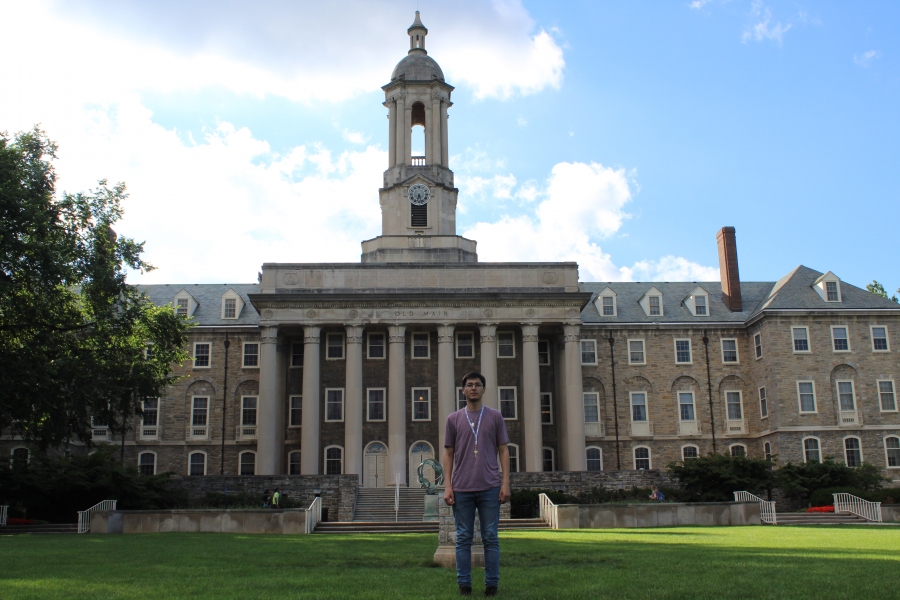News
Sedimentation study has wide applications
A group of researchers from the Universidad de Concepción, UdeC, collaborates with the Universidad de Sevilla (Spain) to develop mathematical models on polydisperse sedimentation applicable to various problems. “Currently, this is my area of study and also the design of numerical methods that allow us to obtain a numerical solution of the model obtained”, details Víctor Osores, former graduate student of the Center for Research in Mathematical Engineering, CI²MA, a graduate of the PhD program in Applied Sciences with a minor in Mathematical Engineering, both from UdeC, and the main person in charge of this research.
“The polydisperse sedimentation process is present in many areas: in geophysical and industrial problems, sedimentation processes are also carried out in the blood, in the preparation of tea cup, among others. It is a topic of great interest and has many applications, therefore, knowing a mathematical model that describes this phenomenon allows, after obtaining a numerical method, to simulate the sedimentation process on different scenarios from our computer”, Osores.
The research group is also conformed by the researcher from the Department of Applied Mathematics from the Universidad de Sevilla, Enrique Fernández-Nieto; the academician from the Faculty of Forestry Sciences (FCF) from the UdeC, Santiago Yépez; and the CI²MA researcher and Professor at the UdeC Department of Mathematical Engineering, Raimund Bürger.
Regarding his motivations to develop this research topic, Osores explains that upon finishing his undergraduate studies in Mathematical Civil Engineering at UdeC, after having learned about the development and applications of hyperbolic differential equations in some classic models such as vehicular traffic and vertical one-dimensional sedimentation, and in search of a subject for his undergraduate memory, he approached Professor Bürger, who showed him a work that he was developing in conjunction with Fernández-Nieto. “Everything was born there, and from there to the present we have made important advances in the area”, explains Osores.
The researcher explains that these results have led him to currently collaborate with academicians from the FCF, through Professor Yépez, addressing various phenomena such as the prediction of flood zones due to the breaking of dams or rains, the projection of sediment accumulation within dams and, on the other hand, “analyze the energy loss of a tsunami in relation to the density of trees on the coast”, all of which have a high social impact.
.jpg) As a result of these studies, an article co-written by Osores, Bürger and Fernández-Nieto will soon be published in the Journal of Scientific Computing and, “together with Professor Yépez we have designed the South Rivers Toolbox software, which allows obtaining morphological information of rivers, such as flood valley, active channel center, river sinuosity, bathymetries and other important metrics, through the analysis of satellite images, data that will help us to simulate sedimentation processes on real scenarios and adjust our models”, Osores details. This computational development is the product of the Corfo 19BP-117424 project directed by Yépez.
As a result of these studies, an article co-written by Osores, Bürger and Fernández-Nieto will soon be published in the Journal of Scientific Computing and, “together with Professor Yépez we have designed the South Rivers Toolbox software, which allows obtaining morphological information of rivers, such as flood valley, active channel center, river sinuosity, bathymetries and other important metrics, through the analysis of satellite images, data that will help us to simulate sedimentation processes on real scenarios and adjust our models”, Osores details. This computational development is the product of the Corfo 19BP-117424 project directed by Yépez.
The researcher explains that some models developed so far are not adequately adjust to the complex reality of the problems they address, since “they do not satisfy a global law of conservation of mass and momentum. Our model does, that is, the mixture behaves like a single-phase fluid”, he details. “Also, in our work we have proposed a modification for a classical model that models the multispecies sedimentation rate (MLB_velocity). We have introduced terms of sediment compressibility and viscosity, achieving a model that little by little is closer to reality”, he says.
Bürger, in turn, emphasizes that “our colleague Santiago Yépez and the Faculty of Forestry sciences are offering an excellent opportunity for a graduate of our doctoral program to join a new, fruitful and stimulating working environment, and not only to widen his theoretical base of knowledge but also to apply it to a number of highly relevant problems for the country, both from a geophysical as well as from an economic point of view.
“Our current interest is to take these models and simulate real rivers, which will allow us to know flood zones and identify sediment accumulation in small dams to evaluate the existence of possible dam ruptures", Osores explains.
However, he affirms, it is still possible to “improve the model, introducing terms of non-hydrostatic pressure, terms of bottom sediment drag and erosion effects” and, regarding other potential applications of the developed model, Osores details that it could be used in the recovery of water in the mining industry and in the treatment of sewage, among others.


